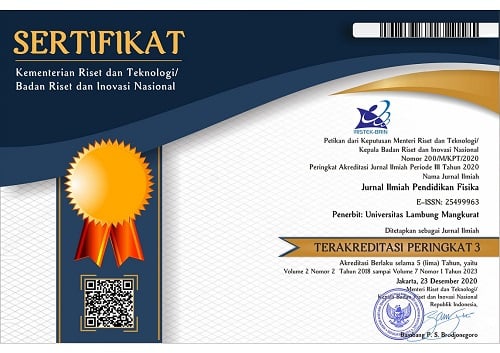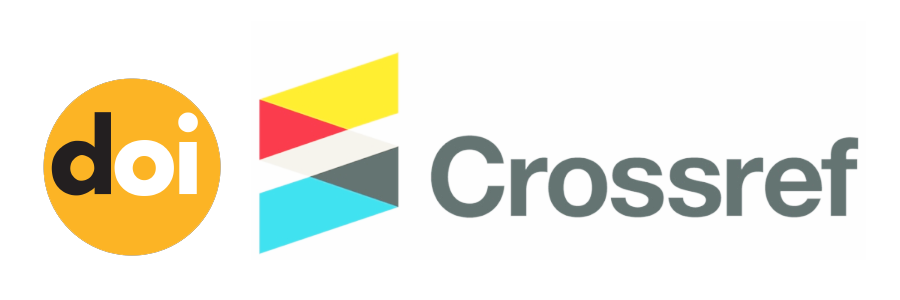Survei Konsepsi Mahasiswa Calon Guru Fisika Menggunakan Two-TierTest pada Topik Kelistrikan dan Kemagnetan
Abstract
Penelitian ini bertujuan untuk mengidentifikasi konsepsi mahasiswa calon guru Fisika pada topik-topik kelistrikan dan kemagnetan dengan instrumen tes dua tingkat yang dikenal dengan istilah lain sebagai two-tier test. Jenis penelitian ini merupakan penelitian survei. Sampel penelitian adalah mahasiswa calon guru fisika tingkat pertama sampai tingkat ke tiga yang telah mengambil mata kuliah Fisika Dasar Lanjut yang berjumlah 95 orang. Instrumen penelitian yang digunakan berupa tes pilihan ganda dua tingkat (two-tier test) terkait materi kelistrikan dan kemagnetan dalam perkuliahan Fisika Dasar Lanjut. Tes ini terdiri dari 40 butir soal yang terdistribusi pada 20 butir soal tentang kelistrikan dan 20 butir soal lainnya tentang topik kemagnetan. Seluruh data dianalisis menggunakan analisis statistik deskriptif dengan pengkategorisasian konsepsi mahasiswa dibedakan atas empat tipe. Hasil penelitian menunjukkan bahwa secara keseluruhan, mahasiswa calon guru fisika berada pada kategori tipe tidak utuh (tipe 4). Temuan penelitian ini dapat berfungsi sebagai need assessment yang berimplikasi pada pertimbangan dalam merancang desain perkuliahan yang dapat memfasilitasi mahasiswa dalam memahami konsep terkait materi kelistrikan dan kemagnetan yang terdapat pada materi perkuliahan Fisika Dasar Lanjut.
This study aimed to show prospective physics teachers' students' conception of electricity and magnetism using a two-tier test. This type of research was survey research. The research subject is all prospective physics teacher students who have taken the Advanced Basic Physics course, totalling 90 students from three grade levels. The research instrument used a two-tier test consisting of a description of the question, answer choices and open reasons related to electricity and magnetism, which were part of the content of the Advanced Basic Physicscourse material. This test consisted of 40 questions distributed over 20 items on electricity topics and 20 items other than magnetism topics. All data were analyzed using descriptive statistical analysis by categorizing students' conceptions into four types. Overall, the results showed that prospective physics teacher students were in type 4 or incomplete. The findings of this study can serve as a need assessment which has implications for considerations in designing learning that can facilitate students in understanding the concepts of electricity and magnetism in the Advanced Basic Physics course.
Keywords
Full Text:
PDFReferences
Astra, I. M. (2018). Pengaruh penggunaan penilaian berdasarkan fortopolio terhadap prestasi belajar fisika siswa. Jurnal Teknodik, 13(1), 18–34.
Azizah, Z., Taqwa, M. R. A., &Assalam, I. T. (2020). Analisis pemahaman konsep fisika peserta didik menggunakan instrumen berbantukan quizizz. Edu Sains: Jurnal Pendidikan Sains Dan Matematika, 8(2), 1–11.
Binkley, M., Erstad, O., Herman, J., Raizen, S., Ripley, M., Miller-Ricci, M., & Rumble, M. (2012). Assessment and teaching of 21st century skills. In Assessment and teaching of 21st century skills (Vol. 9789400723). Springer. https://doi.org/10.1007/978-94-007-2324-5.
Bond, T. G., & Fox, C. M. (2015). Applying the rasch model: fundamental measurement in sciences. Routledge Taylor & Francis Group.
Chang, S. C., Hsu, T. C., Kuo, W. C., & Jong, M. S. Y. (2020). Effects of applying a VR-based two-tier test strategy to promote elementary students’ learning performance in a Geology class. British Journal of Educational Technology, 51(1), 148–165. https://doi.org/10.1111/bjet.12790
Dega, B. G., Kriek, J., & Mogese, T. F. (2013). Students’ conceptual change in electricity and magnetism using simulations: A comparison of cognitive perturbation and cognitive conflict. Journal of Research in Science Teaching, 50(6), 677–698. https://doi.org/10.1002/tea.21096
Driver, R. (1981). Pupils’ alternative frameworks in science. European Journal of Science Education, 3(1), 93–101. https://doi.org/10.1080/0140528810030109
Engelhardt, P. V., & Beichner, R. J. (2004). Students’ understanding of direct current resistive electrical circuits. American Journal of Physics, 72(1), 98–115. https://doi.org/10.1119/1.1614813
Fraenkel, J. R., & Wallen, N. E. (2009). how to design and evaluate research in education. In McGraw-Hill (Seven Edit). McGraw-Hill Companies.
Hakim, M. (2021). Pengembangan video pembelajaran berbasis discovery untuk mereduksi miskonsepsi pada materi kinematika gerak lurus. Universitas Jambi.
Halloun, I. (2007). Inventory of Basic Conceptions—DC Circuits (IBCDC) (PhysPort, 2007),. PhysPort. https://www.physport.org/%0Aassessments/assessment.cfm?I=96&A=IBCDC.
Hekkenberg, A., Lemmer, M., & Dekkers, P. (2015). An Analysis of Teachers ’ Concept Confusion Concerning Electric and Magnetic Fields. African Journal of Research in Mathematics, Science and Technology, 8457(January 2016), 34–44. https://doi.org/10.1080/10288457.2015.1004833
Ivanjek, L., Morris, L., Schubatzky, T., Hopf, M., Burde, J. P., Haagen-Schützenhöfer, C., Dopatka, L., Spatz, V., & Wilhelm, T. (2021). Development of a two-tier instrument on simple electric circuits. Physical Review Physics Education Research, 17(2), 20123. https://doi.org/10.1103/PhysRevPhysEducRes.17.020123
Kanli, U. (2015). Using a Two-tier Test to Analyse Students’ and Teachers’ Alternative Concepts in Astronomy. Science Education International, 26(2), 148–165.
Karal, I. S., & Alev, N. (2016). Development of pre-service physics teachers’ pedagogical content knowledge (PCK) throughout their initial training. Teacher Development, 20(2), 162–180. https://doi.org/10.1080/13664530.2015.1124138
Khasanah, U., & Setiawan, A. (2015). Survey konsepsi mahasiswa calon guru fisika pada konsep listrik statis menggunakan tkls dengan format tes pilihan ganda respon terbuka. Prosiding Simposium Nasional Inovasi Dan Pembelajaran Sains, 8.
Khasanah, U., & Setiawan, A. (2015). Survey konsepsi mahasiswa calon guru fisika pada konsep listrik statis menggunakan tkls dengan format tes pilihan ganda respon terbuka. 2015(Snips), 569–572.
Kusairi, S., & Zulaikah, S. (2017). Diagnosis miskonsepsi siswa SMA di Kota Malang pada konsep suhu dan kalor menggunakan three tier test. Jurnal Pendidikan Fisika Dan Teknologi, 2(3), 95–105.
Leppävirta, J. (2012). The effect of naïve ideas on students’ reasoning about electricity and magnetism. Research in Science Education, 42(4), 753–767. https://doi.org/10.1007/s11165-011-9224-7
Li, F. Y., Hwang, G. J., Chen, P. Y., & Lin, Y. J. (2021). Effects of a concept mapping-based two-tier test strategy on students’ digital game-based learning performances and behavioral patterns. Computers and Education, 173(January), 104293. https://doi.org/10.1016/j.compedu.2021.104293
Lin, J. W. (2016). Development and evaluation of the diagnostic power for a computer-based two-tier assessment. Journal of Science Education and Technology, 25(3), 497–511. https://doi.org/10.1007/s10956-016-9609-5
Marzano, R. J. (2006). Classroom assessment & grading that work. Association for Supervision and Curriculum Development.
Minium, E. W., King, B. M., & Bear, G. (1993). Statistical reasoning in psychology and education third edition (third edit). John Wiley & Sons, Inc.
Muna, I. A. (2016). Identifikasi miskonsepsi mahasiswa PGMI pada konsep hukum newton menggunakan certainty of response index (CRI). Cendekia: Jurnal Kependidikan Dan Kemasyarakatan, 13(2), 309–322.
Mutmainna, D., Mania, S., & Sriyanti, A. (2018). Pengembangan instrumen tes diagnostik pilihan ganda dua tingkat untuk mengidentifikasi pemahaman konsep matematika. MaPan: Jurnal Matematika Dan Pembelajaran, 6(1), 56–69.
Neumann, I., Neumann, K., & Nehm, R. (2011). Evaluating instrument quality in science education: Rasch-based analyses of a nature of science test. International Journal of Science Education, 33(10), 1373–1405. https://doi.org/10.1080/09500693.2010.511297
Nugraha, M., & Novari, A. F. (2018). Penggunaan multimedia interaktif untuk meningkatkan kemampuan penguasaan konsep IPA. Mendidik: Jurnal Kajian Pendidikan Dan Pengajaran, 4(2), 120–130.
Peşman, H., & Eryilmaz, A. (2010). Development of a three-tier test to assess misconceptions about simple electric circuits. Journal of Educational Research, 103(3), 208–222. https://doi.org/10.1080/00220670903383002
Popham, W. (2011). Classroom Assessment What Teachers Need to Know (7th ed.). Pearson.
Pujiyati, P. (2018). Pengembangan instrumen tes diagnostik two tier untuk mendeteksi miskonsepsi fisika peserta didik sma 3 mataram tahun ajaran 2017/2018. Universitas Mataram.
Rahmawati, R., Syamsuddin, A., Marisda, D. H., & Nasrah, N. (2021). Kajian konseptual multirepresentasi pada materi perkuliahan kelistrikan. Seminar, Prosiding Pendidikan, Nasional Ii, I P A, 40–53.
Rahmawati, Rustaman, N. Y., Hamidah, I., & Rusdiana, D. (2018a). The development and validation of conceptual knowledge test to evaluate conceptual knowledge of physics prospective teachers on electricity and magnetism topic. Jurnal Pendidikan IPA Indonesia, 7(4), 483–490. https://doi.org/10.15294/jpii.v7i4.13490
Rahmawati, Rustaman, N. Y., Hamidah, I., & Rusdiana, D. (2018b). The development and validation test to evaluation conceptual knowledge of prospective physics teachers on electricity and magnetism topic. Jurnal Pendidikan IPA Indonesia, 7(4), 483–490. https://doi.org/10.15294/jpii.v7i4.13490
Samudra, G. B., Suastra, I. W., & Suma, K. (2014). Permasalahan-permasalahan yang dihadapi siswa SMA di kota singaraja dalam mempelajari fisika. Jurnal Pendidikan Dan Pembelajaran IPA Indonesia, 4(1).
Setiawan, D. (2013). Penerapan bidang miring untuk mengetahui konsepsi dan keterampilan proses siswa smk terhadap konsep gaya gesek. Universitas Negeri Semarang.
Sokoloff, D. (1996). Electric circuits conceptual evaluation (ECCE). PhysPort. https://www.physport.org/%0Aassessments/assessment.cfm?I=25&A=ECCE
Sugiana, I. N., Harjono, A., Sahidu, H., & Gunawan, G. (2017). Pengaruh model pembelajaran generatif berbantuan media laboratorium virtual terhadap penguasaan konsep fisika siswa pada materi momentum dan impuls. Jurnal Pendidikan Fisika Dan Teknologi, 2(2), 61–65.
Sukadi, E., & Sari, I. N. (2016). Miskonsepsi mahasiswa pendidikan fisika stkip pgri pontianak pada materi listrik statis. Jurnal Pendidikan Informatika Dan Sains, 2(2), 102–109.
Sumintono, B. (2018). Rasch model measurement as tools in assessment for (issue october 2017). ResearchGate. https://doi.org/10.2991/icei-17.2018.11
Suryawirawati, I. G., Ramdhan, B., & Juhanda, A. (2018). Analisis Penurunan Miskonsepsi Siswa Pada Konsep Pemanasan Global Dengan Tes Diagnostik (Two-Tier Test) Setelah Pembelajaran Predict-Observe-Explain (Poe). Journal Of Biology Education, 1(1), 93. https://doi.org/10.21043/jobe.v1i1.3361
Svetina, D., & Levy, R. (2014). A Framework for dimensionality assessment for multidimensional item response models. Educational Assessment, 19(1), 35–57. https://doi.org/10.1080/10627197.2014.869450
Tamir, P. (1990). Justifying the selection of answers in multiple choice items. International Journal of Science Education, 12(5), 563–573. https://doi.org/10.1080/0950069900120508
Taufiq, M. (2012). Remediasi miskonsepsi mahasiswa calon guru fisika pada konsep gaya melalui penerapan model siklus belajar (learning cycle) 5E. Jurnal Pendidikan IPA Indonesia, 1(2).
Wahyuni, A. S. A. (2018). Konsepsi dan miskonsepsi siswa, mahasiswa calon guru, dan guru pada topik cahaya dalam pembelajaran fisika. Jurnal Pendidikan Fisika, 6(3), 235–250.
Xiao, Y., Fritchman, J. C., Bao, J. Y., Nie, Y., Han, J., Xiong, J., Xiao, H., & Bao, L. (2019). Linking and comparing short and full-length concept inventories of electricity and magnetism using item response theory. Physical Review Physics Education Research, 15(2), 20149. https://doi.org/10.1103/PhysRevPhysEducRes.15.020149
Zacharia, Z. C., & de Jong, T. (2014). The effects on students’ conceptual understanding of electric circuits of introducing virtual manipulatives within a physical manipulatives-oriented curriculum. Cognition and Instruction, 32(2), 101–158. https://doi.org/10.1080/07370008.2014.887083
Zhang, T., Chu, C. C., & Gadh, R. (2016). A two-tier energy management system for smart electric vehicle charging in UCLA: A Solar-To-Vehicle (S2V) case study. IEEE PES Innovative Smart Grid Technologies Conference Europe, 288–293. https://doi.org/10.1109/ISGT-Asia.2016.7796400
DOI: https://doi.org/10.20527/jipf.v6i1.4763
Refbacks
- There are currently no refbacks.
Indexed by: Jurnal Ilmiah Pendidikan Fisika is licensed under a creative commons attribution-share alike 4.0 international license
Statistics Counter |

















